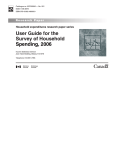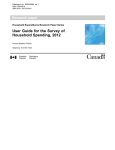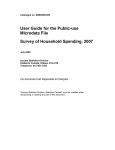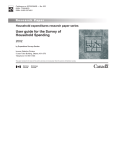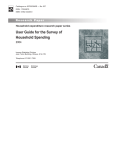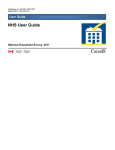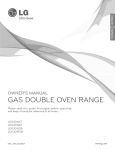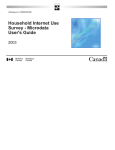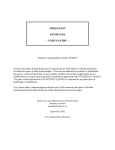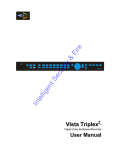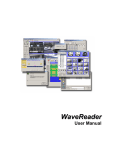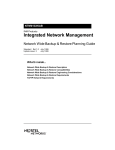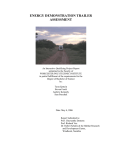Download User Guide for the Survey of Household Spending, 2005
Transcript
Catalogue no. 62F0026MIE — No. 001 ISSN: 1708-8879 ISBN: 0-662-44657-6 Research Paper Household expenditures research paper series User Guide for the Survey of Household Spending, 2005 Income Statistics Division Jean Talon Building, Ottawa, K1A 0T6 Telephone: 613-951-7355 How to obtain more information Specific inquiries about this product and related statistics or services should be directed to: Income Statistics Division, Statistics Canada, Ottawa, Ontario, K1A 0T6 (telephone: 613-951-7355; 888-297-7355; [email protected]). For information on the wide range of data available from Statistics Canada, you can contact us by calling one of our toll-free numbers. You can also contact us by e-mail or by visiting our website at www.statcan.ca. National inquiries line National telecommunications device for the hearing impaired Depository Services Program inquiries Fax line for Depository Services Program E-mail inquiries Website 1-800-263-1136 1-800-363-7629 1-800-700-1033 1-800-889-9734 [email protected] www.statcan.ca Information to access the product This product, catalogue no. 62F0026MIE, is available for free in electronic format. To obtain a single issue, visit our website at www.statcan.ca and select Publications. Standards of service to the public Statistics Canada is committed to serving its clients in a prompt, reliable, courteous, and fair manner. To this end, the Agency has developed standards of service that its employees observe in serving its clients. To obtain a copy of these service standards, please contact Statistics Canada toll free at 1-800-263-1136. The service standards are also published on www.statcan.ca under About us > Providing services to Canadians. Statistics Canada Income Statistics Division Household expenditures research paper series User Guide for the Survey of Household Spending, 2005 Published by authority of the Minister responsible for Statistics Canada © Minister of Industry, 2006 All rights reserved. The content of this electronic publication may be reproduced, in whole or in part, and by any means, without further permission from Statistics Canada, subject to the following conditions: that it be done solely for the purposes of private study, research, criticism, review or newspaper summary, and/or for non-commercial purposes; and that Statistics Canada be fully acknowledged as follows: Source (or “Adapted from”, if appropriate): Statistics Canada, year of publication, name of product, catalogue number, volume and issue numbers, reference period and page(s). Otherwise, no part of this publication may be reproduced, stored in a retrieval system or transmitted in any form, by any means—electronic, mechanical or photocopy—or for any purposes without prior written permission of Licensing Services, Client Services Division, Statistics Canada, Ottawa, Ontario, Canada K1A 0T6. December 2006 Catalogue no. 62F0026MIE ISSN 1708-8879 ISBN 0-662-44657-6 Frequency: Occasional Ottawa Cette publication est disponible en français sur demande (no 62F0026MIF au catalogue). Note of appreciation Canada owes the success of its statistical system to a long-standing partnership between Statistics Canada, the citizens of Canada, its businesses, governments and other institutions. Accurate and timely statistical information could not be produced without their continued cooperation and goodwill. Symbols The following standard symbols are used in Statistics Canada publications: . not available for any reference period .. not available for a specific reference period … not applicable p preliminary r revised x suppressed to meet the confidentiality requirements of the Statistics Act E use with caution F too unreliable to be published Table of Contents Introduction ..................................................................................................................... 6 Survey methodology....................................................................................................... 7 The survey universe.......................................................................................................... 7 Survey content and reference period ................................................................................ 7 The sample ....................................................................................................................... 8 Data collection................................................................................................................... 8 Data processing and quality control .................................................................................. 8 Weighting, re-weighting, and Census historical revision of SHS ...................................... 9 Data quality.................................................................................................................... 11 Sampling error................................................................................................................. 11 Non-sampling error ......................................................................................................... 13 The effect of large values................................................................................................ 14 Comparability over time .................................................................................................. 15 Definitions...................................................................................................................... 16 General concepts ............................................................................................................ 16 Household characteristics ............................................................................................... 17 Selected household expenditures ................................................................................... 19 Dwelling characteristics................................................................................................... 22 Household equipment ..................................................................................................... 24 Classification categories for standard tables................................................................... 25 Statistics presented in the standard tables ..................................................................... 28 The relationship between expenditure estimates from the SHS and the System of National Accounts ...................................................................................... 30 How to use expenditure data tables............................................................................ 32 1. How to calculate the number of households reporting a purchase ..................... 32 2. How to calculate the average expenditure per household reporting a purchase.............................................................................................................. 32 3. How to calculate average expenditure per person .............................................. 33 4. How to calculate percentage of total average expenditure per household (budget share) ..................................................................................................... 33 5. How to combine expenditure items into your own groupings .............................. 33 6. How to combine columns of data ........................................................................ 34 7. How to calculate total expenditure on an item for all households or a sub-group of households..................................................................................... 34 8. How to calculate percentage of total expenditure for all households (market share) ..................................................................................................... 35 Related products and services .................................................................................... 36 Introduction This guide presents information of interest to users of data from the 2005 Survey of Household Spending (SHS). Data were collected via personal interviews conducted in January, February and March 2006 using a paper questionnaire. Information was gathered about the spending habits, dwelling characteristics and household equipment of Canadian households during 2005. The survey covered private households in the 10 provinces and in the three northern territories. (In order to reduce response burden for northern households, the SHS is conducted in the north only every second year, starting with 1999.) This guide includes definitions of survey terms and variables, and descriptions of survey methodology, data quality and the content of standard data tables. There is also a section describing the various statistics that can be created using expenditure data (e.g., budget share, market share, and aggregate spending). Coefficients of variation are available by special request (contact Client Services, Income Statistics Division, 1-888-297-7355; [email protected]). The Survey of Household Spending (first conducted for the 1997 reference year) includes most of the content from the former Family Expenditure Survey and the Household Facilities and Equipment Survey. For more information about the transition from these surveys to the Survey of Household Spending, please contact Client Services (1-888-297-7355 or 613-951-7355; [email protected]), Income Statistics Division. This guide is intended to accompany the standard data tables. The content of these tables is found in the section Products from the Survey of Household Spending. Custom tabulations, including tabulations of revised data from previous survey years, are also available on a cost-recovery basis subject to data quality and confidentiality constraints. For more information about survey results and related products and services, contact Client Services (613-951-7355; 1-888-297-7355; fax 613-951-3012; [email protected]), Income Statistics Division. Statistics Canada 6 Catalogue no. 62F0026MIE Survey methodology The survey universe The 2005 Survey of Household Spending was carried out in private households in Canada’s 10 provinces and three territories.1 The following groups were excluded from the survey: • • • • • those living on Indian reserves and crown lands (with the exception of the territories); official representatives of foreign countries living in Canada and their families; members of religious and other communal colonies; members of the Canadian Forces living in military camps; and people living full time in institutions: for example, inmates of penal institutions and chronic care patients living in hospitals and nursing homes. The survey covers about 98% of the population in the 10 provinces. In the Territories, coverage was restricted to 91.7% in the Yukon, 91.5% in the Northwest Territories and 68.3% in Nunavut. Note that the coverage in Nunavut for 2005 has decreased from the figure of 91.4% in previous surveys, due to changes in sampling. Users should be aware that this will affect comparisons of aggregates with previous time periods. Comparisons of averages over time in Nunavut will be less affected. Information was not gathered from persons temporarily living away from their families (for example, students at university), because it would be gathered from their families if selected. In this way, double counting of such individuals was avoided. Data from part-year households were excluded from estimates of average household spending. However, these data were included in the estimates for dwelling characteristics and household equipment and in the calculation of the Survey of Household Spending response rate. Data from part-year households are also required as input into Statistics Canada’s System of National Accounts. Part-year households are composed entirely of persons who were members of other households for part of the reference year. There were 431 part-year households in the sample in 2005. Survey content and reference period Detailed information was collected about expenditures for consumer goods and services, changes in assets, mortgages and other loans, and annual income. This information was collected for the calendar year 2005 (the survey reference year). Information was also collected about dwelling characteristics (e.g., type and age of heating equipment) and household equipment (e.g., appliances, communications equipment, and vehicles). This type of information was collected as of December 31st of the reference year. Because the Survey of Household Spending is designed principally to provide detailed information on non-food expenditures, only an overall estimate of food expenditure is 1. In order to reduce response burden for northern households, the Survey of Household Spending is conducted in the north only for odd-numbered reference years, starting with 1999. Statistics Canada 7 Catalogue no. 62F0026MIE recorded. Detailed information on food expenditure is provided by the Food Expenditure Survey, which is conducted every four to six years. It was last conducted in 2001. In February 2003, the results were published in Food Expenditure in Canada, 2001, Catalogue no. 62-554-X. The sample The sample size for the 2005 Survey of Household Spending was 21,331 eligible households. The SHS sample was a stratified, multi-stage sample selected from the Labour Force Survey (LFS) sampling frame. Sample selection comprised two main steps: the selection of clusters (small geographic areas) from the LFS frame and the selection of dwellings within these selected clusters. The LFS has undergone a major sample redesign.2 The new LFS sampling frame mainly uses 2001 Census geography and 2001 population counts.3 Data collection The 2005 Survey of Household Spending was conducted from January to March 2006. Data were collected during a personal interview using a paper questionnaire. A copy of this questionnaire is available on request. Data processing and quality control Data entry and automated editing for the 2005 Survey of Household Spending took place in the Statistics Canada regional offices. This allowed respondents to be contacted in the event that more information was required to resolve an inconsistency on their questionnaires. After data entry, an automated edit system checked for data entry errors. Data had to pass a two-tier edit system consisting of “must-pass” edits that checked questionnaires for logic and consistency, and “warnings” that indicated that a particular situation was unusual and could require correction. Either type of edit resulted in the intervention of a member of one of the specially trained edit resolution teams. Further editing of the data took place in head office where invalid responses were corrected. Missing responses were imputed using the nearest neighbour method. Statistics Canada’s Canadian Census Edit and Imputation System (CANCEIS) was used to insert values from donor records having similar characteristics, chosen specifically to fit the variable. For example, total household income was used for most variables; dwelling type, household size and province were also frequently used. 2. For an explanation of the modifications made to the Labour Force Survey estimates, see Improvements to the Labour Force Survey (LFS), Statistics Canada, Catalogue no. 71F0031X. 3. A detailed description of the previous Labour Force Survey sampling frame can be found in Methodology of the Canadian Labour Force Survey, Statistics Canada, Catalogue no. 71-526-X. Statistics Canada 8 Catalogue no. 62F0026MIE Tabulation for the 2005 Survey of Household Spending was completed using a PC/client server-based system. This system provides tools (database querying, searching, and viewing capabilities) for spotting systematic errors. Weighting, re-weighting, and Census historical revision of SHS The estimation of population characteristics from a sample survey is based on the idea that each sampled household represents a certain number of other households in addition to itself. These numbers are called the survey weights of the sample. To improve the representativity of the sample, the weights are adjusted so that the estimates from the sample are in line with population totals, or benchmarks, from other independent sources of information that are considered reliable. This is called weight calibration. SHS uses two sources for calibration. The first source is the Census of Population which provides demographic benchmarks. From 1997 to 2003, SHS used benchmarks derived from the 1996 Census. Since the Census is conducted once every five years, Statistics Canada projects the Census results for later years (up to the present), and then revises those estimates when the next Census data become available. The projections use a variety of secondary information, including administrative data on births, deaths and migration. The second source used for adjusting the survey weights for SHS are T4 data from Canada Revenue Agency, which ensures that the estimated distribution of earners in the survey matches the one in the Canadian population. The 2005 SHS uses survey weights which take into account new population projections from the 2001 Census. In order to make these estimates comparable over time, the weights for all previous SHS have to be revised using the new projections. It was decided to take advantage of this historical revision to also introduce an improved calibration strategy for the SHS weights. Improvements to the calibration strategy were deemed necessary to put emphasis on SHS needs (such as the age groups used for calibration) and to take into account the quality of the benchmarks. It was also felt that there were too many benchmarks leading to too many constraints on the weights, and that this produced undesirable results, such as negative weights, which were not acceptable. The changes made were as follows: • Age-sex − At the provincial level, controls for sex have been eliminated. There are 8 age groups (0-6, 7-17, 18-24, 25-34, 35-44, 45-54, 55-64, 65+) instead of the 18 age-sex groups used previously. − No change at the CMA level: two age groups (0-17, 18+) • Controls for the type of household (lone parent and couples with children) were removed. Statistics Canada 9 Catalogue no. 62F0026MIE The following calibrations were unchanged: • No change to the controls for size of household (one person, two persons, 3+) • No change to the T4 adjustments to the weights of the population for income from wages and salaries (0-25th percentile, 25th-50th, 50th-65th, 65th-75th, 75th-95th, 95th-100th) The weights and calibration strategy were implemented for SHS for the years 1997 and onward resulting in revised estimates of household spending for each year. To ensure comparability, users of SHS data should take care that comparisons are made between years that use the revised weights. Due to their smaller population, only two age groups are used for the three northern territories: number of persons under 18 and number of persons 18 and older. The weights are also calibrated to the totals for one-person households, two-person households, and households with three or more persons. Before the historical reweighting the calibration strategy varied slightly between the territories and between survey years. The northern calibration is now consistent across all three territories and over time. Statistics Canada 10 Catalogue no. 62F0026MIE Data quality Sampling error Sampling errors occur because inferences about the entire population are based on information obtained from only a sample of the population. The sample design, the variability of the data, and the sample size determine the size of the sampling error. In addition, for a given sample design, different methods of estimation will result in different sampling errors. The design for the 2005 Survey of Household Spending was a stratified multi-stage sampling scheme. The sampling errors for multi-stage sampling are usually higher than for a simple random sample of the same size. However, the operational advantages outweigh this disadvantage, and the fact that the sample is also stratified improves the precision of estimates. Data variability is the difference between members of the population with respect to spending on a specific item or the presence of a specific dwelling characteristic or piece of household equipment. In general, the greater these differences are, the larger the sampling error will be. In addition, the larger the sample size, the smaller the sampling error. Standard error and coefficient of variation A common measure of sampling error is the standard error (SE). Standard error is the degree of variation in the estimates as a result of selecting one particular sample rather than another of the same size and design. It has been shown that the “true” value of the characteristic of interest lies within a range of +/- 1 standard error of the estimate for 68% of all samples, and +/- 2 standard errors for 95% of all samples. The coefficient of variation (CV) is the standard error expressed as a percentage of the estimate. It is used to indicate the degree of uncertainty associated with an estimate. For example, if the estimate of the number of households having a given dwelling characteristic is 10,000 households, and the corresponding CV is 5%, then the true value is between 9,500 and 10,500 households, 68% of the time and between 9,000 and 11,000 households, 95% of the time. Standard errors for the 2005 Survey of Household Spending were estimated using the “bootstrap” method. This method is suitable for variance estimation of non-smooth statistics such as quintiles. For more information on standard errors and coefficients of variation, refer to the Statistics Canada publication, Methodology of the Canadian Labour Force Survey, Catalogue no. 71-526-X. Coefficients of variation are available by special request (contact Client Services, Income Statistics Division, 1-888-297-7355; [email protected]). Data Suppression For reliability reasons, estimates with CVs greater than 33% should be suppressed. Since CVs are not calculated for all estimates, data suppression for the Survey of Household Spending has been based on a relationship between the CV and the number of households reporting expenditure on an item. Analysis of past survey results Statistics Canada 11 Catalogue no. 62F0026MIE indicates that CVs usually reach this level when the number of households reporting an item drops to about 30. Therefore, data have been suppressed for spending on items reported by fewer than 30 households. However, data for suppressed items do contribute to summary level variables. For example, the expenditure for a particular category of clothing might be suppressed but this amount forms part of the total expenditure estimate for clothing. Approximation of coefficient of variation It is possible to approximate the CV of estimates not represented in the appendices using a relationship between the CV and the number of households that reported spending on an item or having a given dwelling characteristic. Previous studies have shown that the CV of the estimate of an item tends to decrease in proportion to the square root of the number of households having a given dwelling characteristic. As an example, according to Appendix B, the estimated CV for the average household expenditure on rented living quarters for all households in Ontario is 4.61%. To estimate the CV for the average household expenditure on rented living quarters in Toronto, use the following equation. Note that this method provides only an approximation of the CV. CV for average expenditures on rented living quarters by households in Toronto: CV (for all hhlds) x # of hhlds reporting in Ontario # of hhlds reporting in Toronto = 4.61% x (541 / 242) = 4.61% x 1.50 = 6.92% where # of hhlds reporting expenditure on rented living quarters in Ontario = Ontario sample x percentage reporting 100 = 1,751 x 30.9 100 = 541 and where # of hhlds reporting expenditure on rented living quarters in Toronto = Toronto sample x percentage reporting (Toronto) 100 = 1,751 x 30.9 100 = 541 Note: Where it is necessary to calculate a CV for a sub-population at the Canada level (e.g., lone-parent households) the CV for Canada should be used. Statistics Canada 12 Catalogue no. 62F0026MIE Non-sampling error Non-sampling errors occur because certain factors make it difficult to obtain accurate responses or responses that retain their accuracy throughout processing. Unlike sampling error, non-sampling error is not readily quantified. Four sources of non-sampling error can be identified: coverage error, response error, non-response error, and processing error. Coverage error Coverage error results from inadequate representation of the intended population. This error may occur during sample design or selection, or during data collection and processing. Response error Response error may be due to many factors, including faulty design of the questionnaire, interviewers’ or respondents’ misinterpretation of questions, or respondents’ faulty reporting. In the Survey of Household Spending, the difference between receipts and disbursements is calculated as a check on respondents’ recall. This important quality control tool involves the balancing of receipts (income and other money received by the household) and disbursements (total expenditure plus the variable Money flows—assets, loans, and other debts) for each questionnaire. If the difference is greater than 10% of the larger of receipts or disbursements, respondents are contacted again for additional information. This ensures that expenditures, at least at the aggregate level, match household income and other sources of funds. Several features of the survey help respondents recall their expenditures as accurately as possible. First, the survey period is the calendar year because it is probably more clearly defined in people’s minds than any other period of similar length. Second, expenditure on food (about 11% of the average budget in 2005) can be estimated as either weekly or monthly expenses depending on the respondent’s purchasing habits. Third, expenses on smaller items purchased at regular intervals are usually estimated on the basis of amount and frequency of purchase. Purchases of large items (automobiles, for example) are recalled fairly easily, as are expenditures on rent, property taxes, and monthly payments on mortgages. However, even with these items, the accuracy of data depends on the respondent’s ability to remember and willingness to consult records. Non-response error Non-response error occurs in sample surveys because not all potential respondents provide complete information. Total non-response occurs when the interviewer is unable to contact the respondent, no member of the household is able to provide information, or the respondent refuses to participate in the survey. Total non-response is handled by adjusting the basic survey weight for responding households to compensate for non-responding households. For the 2005 Survey of Household Spending, the overall response rate was 71.4%. See “Table 1” for provincial response rates. Statistics Canada 13 Catalogue no. 62F0026MIE In most cases, partial non-response occurs when the respondent does not understand or misinterprets a question, refuses to answer a question, or is unable to recall the requested information. Imputing missing values compensates for this partial non-response. The importance of the non-response error is unknown but in general this error is significant when a group of people with particular characteristics in common refuse to cooperate and where those characteristics are important determinants of survey results. Table 1 Response rates, Canada and provinces and territories, 2005 Eligible 1 households NonRefusals contacts Unusables2 Usables Response 3 rate % Newfoundland and Labrador Prince Edward Island Nova Scotia New Brunswick Quebec Ontario Manitoba Saskatchewan Alberta British Columbia Yukon Northwest Territories Nunavut Canada 1. 1,766 852 1,975 1,827 2,708 3,112 1,928 1,823 2,002 2,408 397 395 217 21,331 117 52 190 103 172 336 153 74 150 159 34 35 32 1,607 251 148 345 293 551 668 296 294 340 437 56 31 13 3,723 48 4 129 94 26 292 37 48 19 51 9 11 11 779 1,350 648 1,311 1,258 1,959 1,816 1,442 1,407 1,493 1,761 298 318 161 15,222 2. Part-year households are included in the calculation of response rates. There were 431 part-year households in 2005. Rejected at the editing stage. 3. Usable/eligible*100 76.4 76.1 66.4 68.9 72.3 58.4 74.8 77.2 74.6 73.1 75.1 80.5 74.2 71.4 Processing error Processing errors may occur in any of the data processing stages, for example, during data entry, editing, weighting, and tabulation. See “Data processing and quality control” for a description of the steps taken to reduce processing error. The effect of large values For any sample, estimates can be affected by the presence or absence of extreme values from the population. These extreme values are most likely to arise from positively skewed populations. The nature of the subject matter of the SHS lends itself to such extreme values. Estimates of totals, averages and standard errors may be greatly influenced by the presence or absence of these extremes. Statistics Canada 14 Catalogue no. 62F0026MIE Comparability over time Conducted since 1997, the Survey of Household Spending integrates most of the content found in the Family Expenditure Survey and the Household Facilities and Equipment Survey. Many variables from these two surveys are comparable to those in the Survey of Household Spending. However, some differences related to the methodology, to data quality and to definitions must be considered before making comparisons. For more information, refer to Note to Former Users of Data from the Family Expenditure Survey and Note to Former Users of Data from the Household Facilities and Equipment Survey, Catalogue no. 62F0026M. Both documents are available free of charge on the Statistics Canada web site (www.statcan.ca). Historical data from the 1997 to the 2003 surveys of household spending have been re-weighted using the weighting methodology described in the section “Weighting”. Historical comparisons between data from those surveys and data from recent years of the Survey of Household Spending should generally be made with re-weighted data, although the differences between survey estimates from the old and new methodologies appear to be minimal at a summary level. Certain populations or variables, however, may be more strongly affected. Starting with the 1997 Survey of Household Spending, “Tenant’s maintenance, repair and alterations” and “Insurance premiums” were reduced by the proportion of rent charged to business. This may affect comparisons with data from previous years. For the 2001 reference year, extra questions were included for use in the weighting of the Consumer Price Index. This change may affect some historical comparisons. For example, in 2001, questions were added under “Personal care” to collect extra information about hair care products, makeup, fragrances, deodorants and oral hygiene products. As a result of these extra questions, respondents may have given more precise information and the increase in the estimated expenditures for Personal care in 2001 may have been caused by an improvement in respondent recall. The effect of additional questions on estimates is difficult to quantify. However, in 2002, when the extra questions were removed, the estimate for Personal care spending decreased again. The section of the questionnaire which covers “Repairs and improvements of owned principal residences” was extensively revised. From 1997 to 2003, this section had three broad questions: “Additions, renovations and other alterations”; “Replacement or new installation of built-in equipment, appliances and fixtures”; and “Repairs and maintenance”. Starting with the 2004 Survey of Household Spending, there were fourteen detailed questions and two columns, giving respondents the opportunity to split the costs for each question between “Repairs and maintenance” and “Improvements and alterations”. Statistics Canada 15 Catalogue no. 62F0026MIE Definitions General concepts Survey universe The 2005 Survey of Household Spending has two reference periods and therefore two survey universes. Expenditure data are collected for the calendar year 2005. Dwelling characteristics and data about household equipment are collected as of December 31st of the reference year. Tabulation Expenditure data are tabulated for full-year households only. Dwelling characteristics and household equipment data are tabulated for full-year and part-year households. Household A person or group of persons occupying one dwelling unit is defined as a “household”. The number of households, therefore, equals the number of occupied dwellings. A full-year household has at least one full-year member; a part-year household is composed entirely of part-year members. Household member A full-year member was a member of the household for the entire year. A part-year member was a member of the household for less than 52 weeks. Expenditure and income information for part-year members is collected for the portion of the year during which they were members of the household or members of another household no longer in existence. Reference person The household member being interviewed chooses which household member should be listed as the reference person after hearing the following definition. “The household reference person is the member of the household mainly responsible for its financial maintenance (e.g., pays the rent, mortgage, property taxes, electricity). This person can be either male or female. When all members of the household share equally, any member may be shown as the reference person.” This person must have been a member of the household on December 31st of the reference year. Reimbursed expenditures These are excluded from the tabulations (e.g., work-related expenses or expenditures covered by insurance). Expenses attributable to a business These are excluded from the tabulations. Negative expenditures Certain values (Separate sale of automobiles and trucks, Winnings from games of chance, and Tax refunds) are presented in the data tables as “negative expenditures” since they represent a flow of money into the household instead of out of it. Statistics Canada 16 Catalogue no. 62F0026MIE Expenditures collected With some minor exceptions, the survey includes spending on all goods and services received in 2005 whether paid for before or after 2005 (such as on an instalment plan). Taxes included All expenditures include the Goods and Services Tax, provincial retail sales taxes, tips, customs duties and any other additional charges or taxes. Gifts Any expenditure may include gifts given to persons outside the household. Only the value of gifts of clothing is reported separately, as well as being included in the summary clothing category. See also the definition of “Gifts of money and contributions”. Insurance settlements Where an insurance settlement was used to repair or replace property, the survey includes only the deductible amount paid for an item. Trade-ins Where a trade in is used to lower the price of an item, most commonly a vehicle, the expenditure amount is the total cost after the trade in. Real estate transactions are excepted. Household characteristics Presented in the same order as they appear on the data tables Number of households in sample refers to the number of households used for data estimation, which includes the number of households sampled, minus vacant dwellings, ineligible households, households that interviewers were unable to contact, households that refused to be interviewed, and households whose questionnaires did not pass editing procedures. For expenditure data tables, only full-year households are included. For tables presenting dwelling characteristics and household equipment, both full-year and part-year households are included. See “Household” under General concepts. Caution should be exercised when making year-to-year comparisons since changes may not be statistically significant. In order to determine whether a change is statistically significant, please refer to the section “Data quality” in the User Guide, where information about sampling error as well as coefficients of variation and how to use them is available. Special caution is necessary when using estimates from small sub-groups (such as certain metropolitan areas) where the sample size is less than 200. Estimated number of households The estimated (weighted) number of private households on December 31st of the reference year. For expenditure data tables, the estimate is based on full-year households only. For tables presenting dwelling characteristics and household equipment, both full-year and part-year households are included in the estimate. See “Household” under General concepts. Statistics Canada 17 Catalogue no. 62F0026MIE Average household size This is the average number of people in a household. In this context, household size is defined as the number of year-equivalent persons. The number of year-equivalent persons is calculated by dividing the number of weeks that members were part of the household by 52. In this way, part year members are counted as fractions of a year-equivalent person. Average household income before tax This includes total household income received in calendar year 2005, income from wages and salaries, self-employment, net rentals, interest and dividends, all pensions, workers' compensation and employment insurance benefits, social assistance and income supplements, child tax benefits, goods and services tax credits, harmonized sales tax credits, provincial tax credits and miscellaneous regular income receipts. Other money receipts Refers to other receipts not included in income such as cash gifts, inheritance, or life insurance settlements. Winnings from games of chance are also included if they exceed the amount spent on games of chance. Money flows—assets, loans and other debts Includes net changes during the reference year (calendar year 2005) in bank balances; money on hand; money owed to the household; money owed by the household; purchase and sale of stocks and bonds, personal property, and real estate; expenditures on home improvements and alterations; and contributions to and withdrawals from registered retirement savings plans. The Family Expenditure Survey, last conducted in 1996, had a similar variable called Average net change in assets and liabilities. For a complete description of the differences between the two variables, see Note to Former Users of Data from the Family Expenditure Survey (Catalogue no. 62F0026M) available free on the Statistics Canada website (www.statcan.ca). Percentage homeowners (at December 31st) The percentage of households living in a dwelling owned (with or without a mortgage) by a member of the household at December 31st of the reference year. Average age of reference person Acts as a general age indicator for the household and uses the reference person's age in years as of December 31st. Prior to 1996, in the Family Expenditure Survey, the age of the husband was used for couple households and the age of the reference person for all other households. See “Reference person” under General Concepts. Statistics Canada 18 Catalogue no. 62F0026MIE Selected household expenditures Presented in the same order as they appear on the data tables Total expenditure Includes Total current consumption, Personal taxes, Personal insurance payments and pension contributions, and Gifts of money and contributions. Caution should be used when comparing total expenditure to total expenditure from 1996 and earlier. See Note to Former Users of Data from the Family Expenditure Survey (Catalogue no. 62F0026M) available free on the Statistics Canada website (www.statcan.ca). Total current consumption Shows the expenses incurred during the reference year for food, shelter, household operations, household furnishings and equipment, clothing, transportation, health care, personal care, recreation, reading materials, education, tobacco products and alcoholic beverages, games of chance, and a miscellaneous group of items. Caution should be used when comparing total current consumption to total current consumption from 1996 and earlier. Prior to 1997, expenditures for gifts were not included in total current consumption. Starting in 1997, these expenditures are reported in the appropriate spending category and therefore contribute to total current consumption. See also “Shelter” and “Miscellaneous expenditures”. Food purchased from stores “Stores” includes frozen food provisioners, outdoor farmers' markets and stands, and all other non service establishments. Food purchased from restaurants “Restaurants” includes refreshment stands, snack bars, vending machines, mobile canteens, caterers and coffee wagons. Shelter Includes expenditures on principal accommodation (either owned or rented) and on other accommodation such as vacation homes or accommodation while travelling. Expenditure on owned principal accommodation includes regular mortgage payments, if any. This definition of shelter differs from that of the Family Expenditure Survey last conducted in 1996. See Note to Former Users of Data from the Family Expenditure Survey (Catalogue no. 62F0026M) available free on the Statistics Canada website (www.statcan.ca). Rent Refers to the net household expense for rent after adjusting for rebates and for any use of the dwelling for business. No adjustment for partial subletting to non household members is made. Receipts from this activity are considered part of household income. Tenants' insurance/Homeowners' insurance The premiums paid in 2005 for fire and comprehensive policies. Premiums covering more than the reference year were not prorated. Statistics Canada 19 Catalogue no. 62F0026MIE Repairs and maintenance (owned living quarters) Covers expenditures for labour and materials for all types of repairs and maintenance. This variable includes expenditures to repair and maintain built-in equipment, appliances and fixtures. Money spent on alterations and improvements is considered to contribute to an increase in assets and is included in Money flows—assets, loans and other debts. An annual data series from 1987 to 2002 (with the exception of 2000) showing household expenditures on repairs and renovations is available from the Homeowner Repair and Renovation Survey (HRRS). However, this survey was cancelled permanently in 2003. The HRRS had been an annual source of detailed estimates of repairs and renovations expenses. See Homeowner Repair and Renovation Expenditure, Catalogue no. 62-201 and Estimating homeowners' expenses on repairs and renovations: recent changes in approach, Catalogue no. 62F0026M. Property taxes and sewage charges Refers to the amount billed, excluding any rebates. Special service charges (e.g., garbage, sewage), local improvements, and water charges are included if these are part of the property tax bill. Property taxes that are included in condominium charges are excluded. Electricity Respondents sometimes report household electricity payments together with their water and sewage payments. This affects estimates of average household expenditure and percentage reporting for “Electricity” and “Water and sewage”. The summary category “Water, fuel and electricity” is unaffected. Traveller accommodation Excludes accommodation that was part of a travel tour (which is included in Package travel tours). Household appliances Refers to the net purchase price after deducting trade-in allowance and any discount. This variable excludes appliances included in the purchase of a home and built-in appliances. Expenditures for the purchase and installation of built-in household equipment, appliances and fixtures (e.g., built-in appliances and wall-to-wall-carpeting) are included with home improvements and alterations. Purchase of automobiles and trucks Refers to the net purchase price, including extra equipment, accessories, and warranties bought when the vehicle was purchased, after deducting any trade-in allowance or separate sales. (Separate sales occur when a vehicle is sold independently by the owner, e.g., not traded in when purchasing or leasing another vehicle.) Health care Includes direct (out-of-pocket) costs and expenditures on insurance premiums. The distinction between premiums for private health insurance plans and publicly funded (provincial) plans is not always clear to respondents. Interviewers are trained to assist, but the variations in coverage and administration among the various provincial health care regimes makes this a difficult task. For this reason, more confidence can be placed in the overall estimate for Health insurance premiums than in the components: Public hospital, medical and drug plans and Private health insurance plans. Statistics Canada 20 Catalogue no. 62F0026MIE Package travel tours This includes at least two components such as transportation and accommodation, or accommodation with food and beverages. Tobacco and smokers’ supplies This includes cigarettes, tobacco, cigars, matches, pipes, lighters, ashtrays, cigarette papers and tubes, etc. Alcoholic beverages This includes those purchased from stores and restaurants. Also included are expenditures on supplies and fees for self-made beer, wine or liquor. Purchases of alcoholic beverages may be under-reported. Games of chance (net) Equal the sum of expenditures on all types of games of chance minus the sum of winnings from all types of games of chance. If total winnings are greater than total expenditures, the amount to be subtracted from expenditures is set to $1 less than the expenditures and the value of the remaining winnings is moved to the variable “Other money receipts”. Miscellaneous expenditures Expenses on other owned property (not principal accommodation or vacation home), legal services not related to dwellings, financial services, dues to unions and professional associations, contributions and dues for social clubs and other organizations, forfeits of deposits, fines, money lost or stolen, the purchase of tools and equipment for work, and other miscellaneous goods and services. Caution should be used when comparing current data for Miscellaneous expenditures to data from the Family Expenditure Survey (1996 or earlier). For a complete description of the differences between the two variables, see Note to Former Users of Data from the Family Expenditure Survey (62F0026MIE2000002) available free on the Statistics Canada website (www.statcan.ca). Personal taxes Income taxes paid in 2005 on 2005 and previous years' incomes plus other personal taxes (e.g., gift taxes, Newfoundland and Labrador school tax) minus income tax refunds received in 2005. Tax credits, such as child tax benefits, goods and services tax credits and provincial tax credits, are included in Average household income before taxes. Personal insurance payments and pension contributions Payments for life insurance, annuities, employment insurance, public and private pension plans, and similar items. For certain uses of the data, some of these items might be regarded as savings, although the relationship between the expenditure and any increase in savings may not be easily determined. This category of expenditure was called Security prior to the 1996 survey. (Registered retirement savings plan (RRSP) contributions are included in Money flows—assets, loans and other debts.) Gifts of money and contributions This includes money and support payments given to persons outside the household or to charity. This does not include money spent on gifts to persons outside the household as was the case in the Family Expenditure Survey. Statistics Canada 21 Catalogue no. 62F0026MIE Dwelling characteristics Dwelling characteristics are collected as of December 31st. Type of dwelling This describes the type of dwelling in which the household resided on December 31st. A dwelling is a structurally separate set of living premises with a private entrance from outside the building or from a common hall or stairway. − A single detached dwelling contains only one dwelling unit and is completely separated by open space on all sides from any other structure, except its own garage or shed. − A single attached dwelling is a double or semi-detached unit (side-by-side) or a row or terrace unit. − The classification apartment includes duplexes (two dwellings, situated one above the other), triplexes, quadruplexes or apartment buildings. − Other dwellings include mobile homes, motor homes, tents, railroad cars or houseboats, which are used as permanent residences and are capable of being moved on short notice. Repairs needed This variable indicates the respondent's perception of the repairs the dwelling needed on December 31st to restore it to its original condition. Remodelling, additions, conversions, or energy improvements that would upgrade the dwelling over and above its original condition are not included. − Major repairs include serious deficiencies in the structural condition of the dwelling, as well as the plumbing, electrical and heating systems. Examples include corroded pipes, damaged electrical wiring, sagging floors, bulging walls, damp walls and ceilings, and crumbling foundation. − Minor repairs include deficiencies in the surface or covering materials of the dwelling and less serious deficiencies in the plumbing, electrical and heating systems. Examples include small cracks in interior walls and ceilings, broken light fixtures and switches, cracked or broken panes, leaking sinks, missing shingles or siding, and peeling paint. − Regular maintenance includes painting, fixing leaking faucets, clogged gutters or eavestroughs, etc. Tenure This variable gives the housing status of the household on December 31st. Note that housing tenure may also refer to the entire reference year. See “Housing tenure” under Classification categories for standard tables. − Owned with mortgage indicates that the dwelling was owned by a household member and that there was a mortgage as of December 31st Statistics Canada 22 Catalogue no. 62F0026MIE − Owned without mortgage indicates that the dwelling was owned by a household member and that there was no mortgage as of December 31st. − Rented indicates that the dwelling was rented by the household for the entire reference year or occupied rent-free as of December 31st. − Mixed tenure includes those households that both owned and rented during the reference year. Year of move Refers to the year the household moved into the dwelling. If the dwelling was occupied by previous generations, the first year of residence for the household member who has occupied the dwelling the longest is recorded. Period of construction (for dwelling occupied on December 31st) This gives the year or period in which the original building was constructed. Number of rooms (for dwelling occupied on December 31st) This includes the kitchen, bedrooms, and finished rooms in the attic or basement. It excludes bathrooms, halls, vestibules and rooms used solely for business purposes. Number of bathrooms (for dwelling occupied on December 31st) This indicates the number of rooms in the dwelling with an installed bathtub and/or shower. Principal heating equipment (for dwelling occupied on December 31st) This indicates the type of heating equipment chiefly used to heat the dwelling in winter. − Steam or hot water systems distribute central heating through radiators located throughout the house and connected by pressure pipes. − Hot air furnaces distribute central heating by a motor-driven fan through vents located throughout the dwelling. (This is the most common central heating system.) Furnaces with a pump are included in this category. − Heating stoves are localized heating units with no central distribution system to other parts of the house (e.g., oil space heater, gas space heater, wood stoves). − Electric heating includes permanently installed baseboard electric heating and other types such as floor or ceiling heating wires in all or most rooms. − Other heating includes cookstoves and any other type of heating equipment not listed above. Age of principal heating equipment installed (for dwelling occupied on December 31st) This indicates how long ago the principal heating equipment was installed. Statistics Canada 23 Catalogue no. 62F0026MIE Principal heating fuel (for dwelling occupied on December 31st) Refers to the winter fuel used in the principal heating equipment (e.g., oil or other liquid fuel, natural gas, propane, electricity, wood or other fuels). Principal heating fuel for hot water (for dwelling occupied on December 31st) Indicates the type of fuel used for the running hot water supply (e.g., oil or other liquid fuel, natural gas, propane, electricity or other fuels such as wood). Principal cooking fuel (for dwelling occupied on December 31st) Indicates the main fuel for the range or stove on which the household does most of the cooking (e.g., natural gas, propane, electricity or other cooking fuels). “Other” includes oil or other liquid fuel and wood. Household equipment At December 31st In general, appliances and equipment are included if they are in working order or will soon be repaired, and are located within the dwelling occupied on December 31st. They must be owned or leased for the exclusive use of the household. Washing machine Washing machines located outside the dwelling and shared with other households are excluded. Clothes dryer Dryers may be electric or gas. Clothes dryers located outside the dwelling and shared with other households are excluded. Dishwasher Dishwashers may be built-in or portable. Freezer A freezer is an individual piece of equipment and not part of a refrigeration unit such as the freezer in a refrigerator. Air conditioner A central air conditioner is designed to cool the air in the entire building and may be located either inside or outside the dwelling unit, for example, in the basement of an apartment block. A window-type air conditioner is installed in a window or through a wall to cool the air in a room. Telephone (includes business use) Telephones used for business are included if the business is conducted in the dwelling. Cordless phones are included. Cellular telephones are excluded. Cellular telephone Handheld text messaging devices with cell phone capability are included. Cordless phones are excluded. Statistics Canada 24 Catalogue no. 62F0026MIE Compact disc player A compact disc player may be a separate unit, part of a component or built in (as in a receiver/cassette recorder/compact disc combination unit). Video cassette recorder Video cassette recorders (VCRs) are units which play videocassettes when attached to a television or monitor. Home computer Computers used exclusively for business purposes are not included. Internet use from home This indicates whether the household accesses the Internet via a computer in the house. It includes cases where a home computer is used to link to a business computer located outside the dwelling for access to the Internet. Excluded are cases where the Internet is accessed directly through a computer located outside the dwelling (e.g., work). Type of Internet connection “Other type of connection” includes telephone line connected to a television and wireless (e.g., cellular telephone, personal digital appliance). Owned vehicles Gives the number of vehicles (car, van/mini-van, truck/sport utility vehicle) owned by members of the household on December 31st completely or partially for private use, excluding those leased. Owned automobiles Gives the number of automobiles owned by members of the household on December 31st completely or partially for private use, excluding those leased. Owned vans or trucks Gives the number of vans, minivans, trucks and sport utility vehicles owned by members of the household on December 31st completely or partially for private use, excluding those leased. Classification categories for standard tables Canada In 1998, 1999, and every second year thereafter starting with 2001, statistics for Canada include the territories. For the other years, Canada-level statistics include the 10 provinces only. Province/territory Refers to the major political divisions of Canada. Data for territories are available for 1997 (coverage insufficient for inclusion in Canada-level statistics), 1998, 1999 and every second year thereafter starting with 2001. Statistics Canada 25 Catalogue no. 62F0026MIE Metropolitan areas The overall concept for delineating metropolitan areas is one of a large urban area together with adjacent urban and rural areas that have a high degree of social and economic integration with this urban area (See the 2001 Census Dictionary, p. 208, Catalogue no. 92-378-X.) For the Survey of Household Spending, data are tabulated based on the 2001 census metropolitan area (CMA) boundaries. In the Survey of Household Spending, only data for the Ontario part of the Ottawa-Gatineau CMA (Ottawa) are tabulated for the metropolitan area. The data for the Quebec part (Gatineau) are included in the data tabulated for the province of Quebec and Canada. The metropolitan areas for which the data are tabulated are: St. John's, Charlottetown-Summerside, Halifax, Saint John, Québec, Montréal, Ottawa, Toronto, Winnipeg, Regina, Saskatoon, Calgary, Edmonton, Vancouver, Victoria, Whitehorse, and Yellowknife. Income Readers requiring official income statistics are directed to the publication Income in Canada, Catalogue no. 75-202.4 In the Survey of Household Spending, income quintiles are used as classifiers in the data tables. In addition, Average household income before tax is a descriptive household characteristic found at the beginning of each expenditure table (see definition under “Household characteristics”). Household income quintiles Income groupings obtained by ranking households in ascending order of total household income and partitioning the households into five groups such that the estimated number of households in each group is the same. In a quintile table, the number of households in the sample for “All classes” is four households higher than the actual number of households in the sample. This is because the sampled household which falls on the threshold between two quintiles represents a number of households, some of which would be allocated to the lower quintile and some to the higher. Since there are four thresholds between quintiles, the number of households in the sample for All classes in a quintile table increases by four. Custom tabulations of other income percentiles and various income groups are available subject to data quality restrictions. Contact Client Services at 1-888-297-7355 or [email protected]. Housing tenure If a household member owned or rented the dwelling(s) in which the household lived during the reference year (calendar year 2005). See also “Tenure” under Dwelling characteristics. 4. Traditionally, the Survey of Consumer Finances (SCF) had been the source of Statistics Canada’s annual income estimates. Starting with data for the 1998 reference year, the Survey of Labour and Income Dynamics (SLID) became the major source of annual cross-sectional income estimates, in addition to producing longitudinal income data. Statistics Canada 26 Catalogue no. 62F0026MIE − All owners refers to households living for the entire reference year in a dwelling owned (with or without mortgage) by a household member. See also “Percentage homeowners (at December 31st)” under Household characteristics. − Owners without mortgage owned the dwelling for the entire reference year and had no mortgage on December 31st. − Owners with mortgage owned the dwelling for the entire reference year and had a mortgage on December 31st. − Renters rented a dwelling for the entire reference year (as a regular tenant, rent free, or with reduced rent). − Mixed tenure includes those households that both owned and rented during the reference year. Household type Households are divided into the following types: − One-person households are households where a dwelling is occupied by only one person. − Couple households are households where the married or common law spouse of the reference person was a member of the household on December 31st. This household type may be further broken down into couple households without children (without additional persons), with children (without additional persons), and with additional persons. “Children” are never-married sons, daughters, or foster children of the reference person and may be any age. “Additional persons” include sons, daughters and foster children whose marital status is other than “single, never-married”, other relatives by birth or marriage, and unrelated persons. − Lone-parent households are households where no spouse of the reference person is present and there is at least one child (never-married son, daughter, or foster child of the reference person). The lone-parent households for which data are presented in this publication do not include any additional persons. − Other households may be broken down into households composed of relatives only and households having at least one household member who is unrelated to the reference person (e.g., lodger, roommate, employee). Relatives may include: • • • Statistics Canada sons, daughters and foster children of the reference person whose marital status is other than single, never-married; relatives of the reference person by birth or marriage (not spouse, son, daughter, or foster child); spouse of the reference person who was not present in the household on December 31st. 27 Catalogue no. 62F0026MIE Size of area of residence Sampled dwellings are assigned to the following groups depending on the 2001 population size (according to the 2001 census boundaries) of the metropolitan area, municipality, or area in which they are located. Urban 1,000,000 and over 500,000–999,999 250,000–499,999 100,000–249,999 30,000–99,999 under 30,000 Rural Urban area For the Survey of Household Spending (based on the LFS sampling frame), urban areas include: − − − all large metropolitan areas (even though they do contain some rural areas); most small metropolitan areas (also called census agglomerations). In some cases, where a census agglomeration contains a large rural population, only the urban portion is considered urban; urban areas based on the census definition: “Urban areas have minimum population concentrations of 1,000 and a population density of at least 400 per square kilometre, based on the previous census population counts.” Rural area All territory outside urban areas is considered rural. Taken together, urban and rural areas cover all of Canada. Statistics presented in the standard tables Average expenditure per household This is equal to the estimated total expenditures of all households divided by the estimated number of households. The average is based on all households in a column, including households that reported a zero value. Percentage reporting The percentage of households that reported purchasing an item. These percentages cannot be added together to form sub-totals. Average expenditure per household reporting This is calculated for those households that reported the expenditure, i.e., without zero values. Average expenditure per household reporting was calculated using unrounded data. Note also that expenditures in this column do not add to sub-totals. Percentage of total expenditure This is calculated by expressing the average expenditure per household as a percentage of total expenditure. This statistic is also known as “budget share”. Statistics Canada 28 Catalogue no. 62F0026MIE Median expenditure per household Expenditure groupings are obtained by ranking households in ascending order of the expenditure on a given item and partitioning the households into two groups such that the estimated number of households in each group is the same. The expenditure reported by the highest ranked case in the first group would be the median. Estimates for individual expenditure items in a given column of a table do not add up to the sub-totals or totals. Households reporting zero expenditures are included. Median expenditure per household reporting Expenditure groupings are obtained by ranking households in ascending order of the expenditure on a given item and partitioning the households into two groups such that the estimated number of households in each group is the same. The expenditure reported by the highest ranked case in the first group would be the median. Estimates for individual expenditure items in a given column of a table do not add up to the sub-totals or totals. Households reporting zero expenditures are not included. Statistics Canada 29 Catalogue no. 62F0026MIE The relationship between expenditure estimates from the SHS and the System of National Accounts Users should note some important differences between estimates of total current consumption from the Survey of Household Spending (SHS) and personal expenditure on consumer goods and services from the System of National Accounts (SNA). Data from the SHS are an important, but by no means the only, source of data used by the SNA in the compilation of their accounts. Current expenditure estimates for both the SHS and the SNA cover all personal outlays on goods and services by Canadian residents at home and abroad. In addition, personal expenditure on consumer goods and services from the SNA includes the operating expenditure of “associations of individuals”, which include private non profit organizations such as charitable institutions, labour unions, private pension funds, mutual funds, mutual insurance companies and similar non-commercial groups serving households. These organizations are regarded as groups of persons acting collectively for the benefit of the community. Estimates from the National Accounts include expenditures made in the northern territories. SHS estimates include data for the north only for years when the survey is conducted there. The SHS has included northern data in its Canada totals for 1997, 1998, 1999, 2001, 2003, and 2005. Data on the expenditures of persons living alone who died, emigrated, or were institutionalized during the survey year are excluded from the SHS but are included in the National Accounts. Unlike the SHS, the National Accounts include data for Canadian residents based overseas, such as diplomats and military personnel. The SHS presents information about the purchase of both new and used goods. In the National Accounts, personal expenditure includes spending on new goods, but for used goods previously owned by the personal sector, only the mark-up is included. Several expenditures that are not directly incurred by household members are assigned imputed values in the National Accounts. For example, National Accounts assigns imputed values for the following: the cost of farm products consumed directly in farm households and the cost of items received by employees in lieu of wages. An imputation is also made for household expenditure on the financial intermediation services of banks and other financial institutions for which no explicit charges are recorded, e.g., the portion of bank interest charges that represent administration costs. In the SHS, shelter expenditures for homeowners include items such as property taxes, homeowners' insurance, regular mortgage payments, utilities, and spending on maintenance and repairs. In the National Accounts, personal spending on shelter for homeowners is determined by imputing a rental value for their dwellings. Statistics Canada 30 Catalogue no. 62F0026MIE Total current consumption in the SHS and total personal expenditure in the National Accounts cover mainly the same categories of goods and services. However, total current consumption in the SHS includes some items that are classified as transfer payments and excluded from total personal expenditure in the National Accounts, such as vehicle licence fees, public medical insurance premiums and the transfer portion of interest on consumer debt. The SHS is able to provide detailed annual expenditure data not only at the national and provincial/territorial level, but also for various metropolitan areas, income groups, and types of households. The SNA provides annual and quarterly data at the national level and annual data at the provincial/territorial level. Statistics Canada 31 Catalogue no. 62F0026MIE How to use expenditure data tables This section explains the calculations used most frequently to manipulate expenditure data from the Survey of Household Spending. Users are strongly advised to refer to this section before doing their own data analysis. Expenditure data given in the tables are estimates based on the total sample, that is, on households that reported buying an item and those that did not. Data on percentage reporting are provided in the tables so that users can derive estimates of both the number of households reporting a purchase and the average expenditure of households that reported buying an item. 1. How to calculate the number of households reporting a purchase Refer to the “Example data” table. To estimate the number of households reporting a purchase, multiply the estimated number of households at the top of the column by the percentage of households reporting and then divide by 100. For example, to find the number of households in the lowest income group that had pet expenditures: Estimated # of households x Percentage reporting pet expenditures 100 Example: 463,590 x 29.4 100 = 136,295 2. How to calculate the average expenditure per household reporting a purchase Refer to the “Example data” table. To calculate the average expenditure per household reporting the purchase of an item, divide the average household expenditure on that item by the corresponding percentage reporting and then multiply by 100. For example, to find the average expenditure on pets by households that actually had pet expenses: Average household expenditure on pet expenses x 100 Percentage reporting Example: Statistics Canada $239 x 100 47.6 32 = $502 Catalogue no. 62F0026MIE 3. How to calculate average expenditure per person Refer to the “Example data” table. To calculate the average expenditure per person on an item, divide the average expenditure per household for that item by the household size found near the top of the column. For example, to find the average expenditure per person for food by those households in the lowest income group: Average expenditure per household for food Household size Example: $2,474 1.29 = $1,918 When comparing estimates of per person expenditure, note that family composition (number of children and adults) is also a factor in many expenditure patterns. 4. How to calculate percentage of total average expenditure per household (budget share) Refer to the “Example data” table. To calculate the percentage of total average household expenditure represented by an item (budget share), divide the average expenditure per household for an item by total expenditure for all items and multiply by 100. For example, to find the percentage of total expenditures represented by food purchases for households in the lowest income group: Average expenditure per household for food x 100 Total average expenditure per household Example: $2,474 x 100 $12,311 = 20.1% 5. How to combine expenditure items into your own groupings Refer to the “Example data” table. The average expenditure per household for different items in a column can be added together to make new subtotals. (But do not add the “percentage reporting” values for different items.) For example, to find the average expenditure per household in the lowest income group on food, shelter and clothing: Statistics Canada 33 Catalogue no. 62F0026MIE Average expenditure on food + clothing + shelter (lowest income group) Example: $2,474 + $427 + $4,426 = $7,327 6. How to combine columns of data Refer to the “Example data” table. Columns are combined by using the estimated number of households at the top of each column to calculate the weighted average of the values in the columns. To calculate the average expenditure across several columns, multiply the estimated number of households by the average expenditure for an item for each of the columns being combined. Sum the results. Then divide this total by the sum of the estimated number of households. For example, to find the average expenditure on food for households in the lowest three income groups: (Estimated # of households in lowest income group x average expenditure on food) + (Estimated # of households in next income group x average expenditure on food) + (Estimated # of households in next income group x average expenditure on food) Estimated # of households in lowest income group + Estimated # of households in next income group + Estimated # of households in next income group Example: (463,590 x $2,474) + (882,370 x $2,881) + (797,740 x $3,518) 463,590 + 882,370 + 797,740 = $3,030 7. How to calculate total expenditure on an item for all households or a sub-group of households Refer to the “Example data” table. To calculate how much was spent on average on an item for all households or households in a particular sub-group (e.g., households in the lowest income group), multiply average expenditure per household for an item by the estimated number of households at the top of the column. For example, to find how much was spent on food by all households in the lowest income group: Average expenditure per lowest income household for food x estimated number of households Example: $2,474 x 463,590 = $1,146,921,660 Note that this aggregate is based on a sample that excludes part year households and other people ineligible for the survey. Statistics Canada 34 Catalogue no. 62F0026MIE 8. How to calculate percentage of total expenditure for all households (market share) Refer to the “Example data” table. Expenditure share, or market share, is the percentage of the total expenditure for an item that can be attributed to a particular sub group of households, e.g., the percentage of all clothing expenditures made by households in the lowest income group. It is calculated by dividing the total expenditure on an item for a given sub group of households (to calculate, see above) by the total expenditure on the item for all households and then multiplying by 100. For example, to find the percentage of all expenditures on food made by households in the lowest income group: Average expenditure per lowest income households on food x Estimated # of households in lowest income group Average expenditure for all households on food x Estimated # of households for all classes Example: $2,474 x 463,590 $5,960 x 10,900,500 x 100 = 1.77% Example data Summary average household expenditure by household income group All classes Under $10,000 $10,000 - $14,999 $15,000 - $19,999 Estimated number of households 10,900,500 463,590 882,370 797,740 Average household size 2.61 1.29 1.52 1.94 Average household expenditure Percentage reporting Average household expenditure Percentage reporting Average household expenditure Percentage reporting Average household expenditure Percentage reporting Food 5,960 100.0 2,474 100.0 2,881 100.0 3,518 100.0 Shelter 8,477 99.9 4,426 99.3 5,051 99.5 5,833 99.9 239 47.6 67 29.4 70 27.2 122 38.2 Clothing 2,115 99.0 427 92.0 615 96.1 840 98.2 Total expenditure 49,068 100.0 12,311 100.0 15,036 100.0 20,143 100.0 Pet expenses Note: These data do not come from the current year’s survey. Statistics Canada 35 Catalogue no. 62F0026MIE Related products and services Detailed tables The following standard tables are also available: • • • • • • • • • • 62F0031X Detailed Average Household Expenditure for Canada, Provinces/Territories and Selected Metropolitan Areas 62F0032X Detailed Average Household Expenditure by Household Income Quintile for Canada and Provinces 62F0033X Detailed Average Household Expenditure by Housing Tenure for Canada 62F0034X Detailed Average Household Expenditure by Household Type for Canada 62F0035X Detailed Average Household Expenditure by Size of Area of Residence for Canada 62F0041X Dwelling Characteristics and Household Equipment for Canada, Provinces/Territories and Selected Metropolitan Areas 62F0042X Dwelling Characteristics and Household Equipment by Income Quintile for Canada 62F0043X Dwelling Characteristics and Household Equipment by Housing Tenure for Canada 62F0044X Dwelling Characteristics and Household Equipment by Household Type for Canada 62F0045X Dwelling Characteristics and Household Equipment by Size of Area of Residence for Canada Household Expenditures Research Paper Series This series provides detailed documentation on issues, concepts, methodology, data quality and other relevant research related to household expenditures from the Survey of Household Spending. • 62F0026MIE Household Expenditures Research Paper Series CANSIM CANSIM (the Canadian Socio-Economic Information Management System) is a data base consisting of multi-dimensional cross-sectional tables. Twenty tables are available. They present annual information from the Survey of Household Spending about the spending habits, dwelling characteristics and household equipment of Canadian households by province/territory and selected metropolitan areas. These tables cover the survey years 1997 to 2005. Table 203-0001 presents summary level expenditure data, while tables 203-0002 to 203-0018 present detailed expenditures. Tables 203-0019 and 203-0020 have household facilities and equipment data. Statistics Canada 36 Catalogue no. 62F0026MIE Custom tabulations For clients with more specialized data needs, custom tabulations can be produced on a cost-recovery basis. Custom tabulations can be produced to your specifications on a contract basis (subject to confidentiality restrictions). Aggregate data at the detailed expenditure level (including both full-year and part-year households) are also available on a custom basis. For more information or to enquire about the concepts, methods, data quality or the product line, contact Client Services (1-888-297-7355 or 613-951-7355; [email protected]), Income Statistics Division. Statistics Canada 37 Catalogue no. 62F0026MIE





































